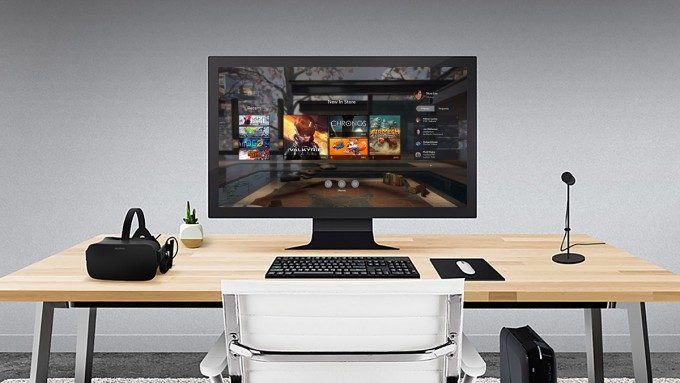Earlier this month we saw a slew of new Oculus Touch game announcements. Many of these new VR titles, which benefit from funding or publishing (or both) by Oculus, will launch exclusively for the Rift and Touch. And while the company has come under fire for that practice in the past, Oculus’ Head of Content defends the decision as the right approach to get the VR market moving.
Last month’s Connect 3 conference saw the reveal of ambitious (and exclusive) new VR content for Oculus Touch, like Robo Recall, Arktika.1, and Lone Echo. With $250 million already invested into VR content and another $250 million on the way, the company shows no signs of slowing its strategy of exclusivity deals.


Jason Rubin is the Head of Content at Oculus, and a veteran of the videogame industry. Known for his work on the Crash Bandicoot franchise and founding of studio Naughty Dog, Rubin has been around the block, and contrasts his experience in the early days of the videogame industry with what’s happening today in virtual reality.
Speaking with Road to VR at Gamescom 2016 earlier this year, Rubin laid out the company’s decision to aggressively invest in VR content, often in exchange for exclusivity agreements.
“A lot of the games you see here today are larger than would be practically financeable by developers and publishers at the launch of a hardware system. When you’re talking about VR, you’re talking about a new hardware that has no past analogue, there is nothing that can be ported well onto VR. There are games that work ok like Project Cars for controller. But when you talk about hand-tracking, there’s nowhere those sorts of games can come from,” Rubin said. “By definition you’re shipping into a zero-person install base when you ship this new hardware. For developers to make large leaps of faith—to do multi-million dollar projects—it simply doesn’t happen without the hardware manufacturers believing in their hardware and believing in the ecosystem and helping those developers out with large grants. There’s no other way that Wilson’s Heart, Chronos, or The Climb gets made.”
Rubin speaks to the chicken-and-egg conundrum of getting developers to make content for a platform with no customers, or getting customers to buy a platform with no content.
“Once those games are out there [customers] say, ‘Oh, there’s great stuff out there. I’m going to buy into VR. I get it now, I understand why I want to play.’ Then they buy the systems, and they’re now an addressable market,” he said. “Then the second or third generation of developer doesn’t need our money. They can see there’s an established userbase there built by first generation games, they can build a bigger title than they would have otherwise because there’s now enough consumers to buy their game. That’s the only way these systems work.”
Looking back at his experience in the early days of the videogame industry, Rubin suggests that not aggressively funding VR content through exclusive deals would mean painfully slow growth for the VR space.
“The other way to [create a sustainable customer/developer ecosystem], is to do it the way PC originally did it which started 30 years ago; I was making games when the PC came out. The way you do it is, you put it in a ziplock bag, you put it on the shelf, somebody buys your ziplock game, and the addressable market gets a little bigger. [Then] you make a better game that you put in a very cheap box and over time it gets to $100 million games. It took 30 years. We don’t want [VR] to take 30 years,” Rubin explained. “We want this generation to race forward. Because we don’t have the luxury that the PC market had, where it was the best-looking thing out there. Well, we’re going up against Grand Theft Auto and Call of Duty. [Gamers] have the ability to play these triple-A games. So if we don’t compete visually [and] depth-wise, if we don’t jump out there and give them great games to play right off the bat, we may never have what the PC had. We may never have the stepping stone. What we are doing now is the only way to viably jumpstart the market.”
Rubin points to the Oculus store and its library of games as proof that the approach is working.
“There have been a lot of suppositions from various parties who haven’t wanted to fund [VR games] about how it could happen elsewhere, or their particular methodology for getting [VR] to spread, but the proof of any system is in its results. The proof is there in our system—funding developers—that’s creating next generation content that other systems have not.”
If the exclusive titles Oculus has helped fund weren’t any good, there probably wouldn’t be much backlash from the community. But it’s clear that some of VR’s most substantial titles are found on Oculus’ platform, even prompting the creation of ‘Revive’, a hack that allows some Oculus exclusive games to be played on the HTC Vive. When the hack was patched by Oculus, outrage from the VR community prompted the company to backpedal on their approach to DRM.
Meanwhile, Sony has taken a similar approach with exclusive funding of VR content for PlayStation VR but rarely sees the level of criticism directed at Oculus. That’s likely due to the fact that platform exclusive titles are a norm in the console space, whereas PC has long been seen as an ‘open’ platform.
Additional reporting by Scott Hayden

